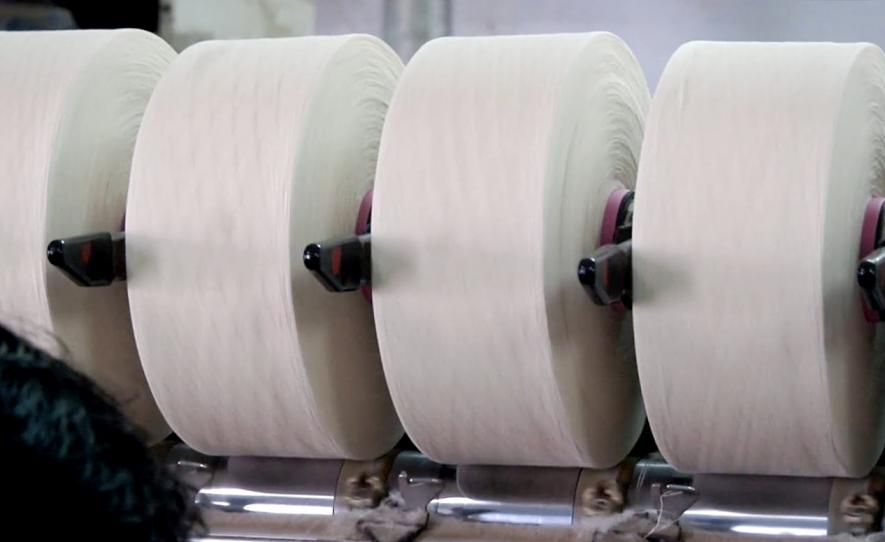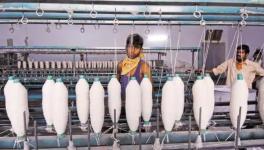TN: Knitwear Capital Tirupur Unable to Recover from Cotton Price Hike

Representational use only.Image Courtesy: ANI
The price of cotton yarn is finally dropping after a sharp rise since November 2021. Yet, the knitwear industry in Tirupur is not picking up and only 50% of production is underway.
Export garment production and production for the domestic market have been severely affected. This has left the large workforce dependent on the textile industry unemployed.
The reduction in purchasing power of the people in foreign and domestic markets has stalled production. Exporters say that the clothes already produced and exported have remained unsold.
Also, the orders in the previous season were diverted to other countries that gave cheaper tariffs leaving Tirupur garment units shut.
There are over 10,000 garment manufacturing industries in Tirupur on which six lakh workers depend.
FEW NEW ORDERS
Garment manufacturers in Tirupur say that knitwear sales have stagnated in the past as well affecting production and employment opportunities, but the current situation is severe.
“The knitwear units are not receiving orders because they are unable to negotiate with the export traders and reach a fair consensus,” a senior journalist Thooyavan Velumani who is based in Tirupur told NewsClick.
“Regarding the increased quotation for production, the export traders say ‘ups and downs in yarn price is your domestic problem, as far as we are concerned we will grant new orders if your asking price is good, otherwise we will look elsewhere’” he added.
Tirupur Exporters And Manufacturers Association (TEAMA) President Muthu Rathinam told NewsClick, “our competition markets such as Bangladesh, Vietnam, Ethiopia and China received orders in the ongoing season because the yarn price was high in India and we could not quote convenient prices.”
“Even the few big domestic garment manufacturing units such as Lux, Amul and Dixcy which manufacture garments to the tune of Rs 10,000 crores per year, are now stocked with pre-made clothes,” Thooyavan said.
“Around 18 months ago the price of one kilo of cotton yarn was Rs 220 and it rose to Rs 460 in May 2022. A more than 100% increase. It has now reduced to Rs 400” he added.
Unable to purchase cotton at this price, the Tirupur industry is shifting to synthetic fibre such as rayon and polyester.
MSME CRUSHED, CORP REAP PROFIT
In this situation, only the large export companies are getting orders, and the small and micro exporters are struggling. Around 90% of the units are Micro, Small and Medium Enterprises (MSME), and only 10% are corporates in Tirupur.
“This is a good time for the 10% corporate garment industries in Tirupur. They have a vertical set-up in which all the nine types of processing for knitwear are in-house,” said Rathinam
“They also have solar and wind energy facilities. They are functioning conveniently, MSMEs are struggling,” he said.
“Moreover the corporates have money and political weight, they get what they want. But, when we want to meet the respective ministers and leaders, we are not given appointments,” he added.
NO JOBS
Although production is underway in the corporate manufacturing units, it does not provide employment to the local population.
Thooyavan said “even if there are jobs in big companies, they give preferential work to other state workers staying in hostels. Not only do they get relatively low wages, but if they are not given jobs they may leave for their hometowns en masse. It is difficult to bring them back when needed”.
“The local workers get minimum and short-time work, they are compelled to share the work and split the pay” he added.
He further said, “a woman worker who used to earn Rs 2,000 a week is now struggling to get Rs 400 a week”.
“The demand for workers known as ‘sample tailors’ is usually high and even they do not have work. Their role is to make sample garments when new orders come in. If there is no work for them, it means new orders are not coming in, there is no production and no employment” said Thooyavan.
After agriculture, weaving is the industry that gives maximum employment in Tamil Nadu. At present, about 70% of conventional garment production is not happening in Tirupur. A direct consequence of this is the unemployment of workers. The industry extensively employs women.
LOCAL ECONOMY IN SHAMBLES
Experts say that even if the Tirupur textile industry recovers from this plight, it is difficult to revert to the golden years of production.
“The row houses in the garment workers' quarters are mostly vacant nowadays. The usual traffic in the city has also reduced. Sales in all commercial shops like petty stores, tea shops, and restaurants have also decreased,” said Thooyavan.
“Successive policies of the BJP government have destabilised the city and plunged it into the dark ages. Demonetisation, GST, increase in prices of raw materials (including yarn, spare parts), overall domestic market decline and people's decreased purchasing power have brought the district to this situation,” he added.
The TEAMA is demanding government intervention to control cotton yarn prices and to categorise cotton as an essential commodity.
Get the latest reports & analysis with people's perspective on Protests, movements & deep analytical videos, discussions of the current affairs in your Telegram app. Subscribe to NewsClick's Telegram channel & get Real-Time updates on stories, as they get published on our website.















